Similar Triangles: Definition, Properties, Formula, Theorem, Examples
Similar triangles are an important part of Geometry and Mathematics. Similar Triangles are triangles that have the same shape but may differ in size. They share key properties such as corresponding angles being equal and corresponding sides being proportional, known as the properties of the similar triangle. The similar triangles formula helps in calculating side lengths and areas, with properties of the area being proportional to the square of corresponding sides. Key similar triangle rules include the AA (Angle-Angle) criterion, SAS (Side-Angle-Side) criterion, and SSS (Side-Side-Side) criterion. The similar triangle symbol is
CAT 2024: 20 Free Mock Test | 10 Year PYQs | 60 Day Study Material | Most Scoring Concepts
XAT 2025: Section-wise Preparation Tips | Sample Paper
Don't Miss: SNAP 2024 Sample Papers | NMAT 2024 Sample Papers | MAT 2024 Sample Papers
Similarity of two figures: Definition
In geometry, two figures are said to be similar if they have the same shape and characteristics but not necessarily the same size. So if we enlarge or shorten them and rotate or reflex, we can get the other figure.
Two figures can be similar if:
All corresponding angles are equal.
The ratios of the lengths of corresponding sides are equal (i.e., the sides are proportional).
Similarity is denoted by the symbol “~”.
If figure A is similar to figure B, then we can say that A ~ B.
Are two Circles always similar?
Yes, two circles are always similar as they are identical in shape.
Are two squares always similar?
Yes, All angles are equal and all sides are in proportion.
Similarity of two triangles
Two triangles are said to be similar if they have the same shape, but not necessarily the same size. This means that their corresponding angles are equal and their corresponding sides are in proportion. Also if we enlarge or shorten one triangle and rotate or reflex, we can get the other triangle.
Two triangles are similar if
Corresponding angles are equal.
Example:
Corresponding sides are proportional.
Example: PQ/XY = QR/XZ = PR/YZ
If triangle PQR is similar to triangle XYZ, then we can say that PQR ~ XYZ.
Criteria of Similarity of two triangles/ Similar triangle theorems
There are several criteria for two triangles to be similar. Those are:
Angle-Angle(AA) Similarity Criterion
Side-Angle-Side(SAS) Similarity Criterion
Side-Side-Side(SSS) Similarity Criterion
Angle-Angle(AA) Similarity Criterion
Angle-Angle(AA) Similarity Criterion states that the triangles are similar if two angles of one triangle are equal to two angles of another triangle.
Suppose there are two triangles ABC and EFG.
Then ABC and EFG are similar triangles if any two pairs of angles between them are equal.
Let
Then,
Side-Angle-Side(SAS) Similarity Criterion
Side-Angle-Side(SAS) Similarity Criterion states that if one angle of a triangle is equal to one angle of another triangle and the sides including these angles are in proportion, the triangles are similar.
Suppose there are two triangles ABC and DEF.
Here, AB = DE
AC = DF
And,
Then,
Side-Side-Side(SSS) Similarity Criterion
Side-Side-Side(SSS) Similarity Criterion states that if the corresponding sides of two triangles are in proportion, the triangles are similar.
Suppose there are two triangles ABC and DEF.
Then we can say ABC and DEF are similar triangles if their sides are in proportion.
Here, AB = DF = 9 cm, AC = DE = 6 cm, and BC = EF = 7 cm
Then,
Writing Similarity Statement:
The following steps are to be taken into consideration
Step 1: Determine the pairs of corresponding angles and pairs of corresponding sides in the triangles.
Step 2: Redraw the triangles following the orientation.
Step 3: Name the triangles and write a similarity statement, so that corresponding vertices are in the same order.
Example:
The triangles in the image below are similar. Write a similarity statement based on the image.
Step 1: Determine the pairs of corresponding angles and pairs of corresponding sides in the triangle.
Corresponding Angles:
∠??? = ∠???
∠??? = ∠???
∠??? = ∠???
Corresponding Sides:
?? and ??
?? and ??
?? and ??
Step 2: Redraw the triangles following their orientation.
Step 3: Name the triangles and write a similarity statement, so that the corresponding vertices are in the
same order.
What is CPST?
The full form of CPST is for “Corresponding Parts of Similar Triangles”. It is a concept in geometry that relates to the properties of similar triangles. When two triangles are similar, their corresponding parts (angles and sides) have specific relationships.
In similar triangles, each pair of corresponding angles is equal.
The lengths of corresponding sides of similar triangles are proportional.
CPST helps to solve problems involving similar triangles by using the relationships between corresponding parts.
Properties of Similar triangles
Corresponding angles of similar triangles are equal.
If ABC ~ XYZ, then ∠A = ∠X, ∠B = ∠Y, and ∠C = ∠Z
Corresponding sides of similar triangles are in proportion.
If ABC ~ XYZ, then AB/XY = BC/YZ = AC/XZ
The ratio of the areas of two similar triangles is equal to the square of the ratio of their corresponding sides.
If ABC ~ DEF, then
The ratio of the perimeters of two similar triangles is equal to the ratio of their corresponding sides.
If ABC ~ DEF, then
In similar triangles, the ratio of the corresponding altitudes, medians, and angle bisectors is equal to the ratio of the corresponding sides.
Comparison between Similar triangles and congruent triangles
Similar triangles | Congruent triangles | |
Definition | Corresponding angles are equal, and sides are proportional. | Corresponding sides and angles are exactly equal. |
Notation | ~ | ≅ |
Corresponding sides | Proportional | Equal |
Corresponding angles | Equal | Equal |
Criteria to be similar or congruent | AA, SAS, SSS Where S = side, A = Angle | SAS, SSS, ASA, AAS, RHS Where S = side, A = Angle, H = Hypotenuse, R = Right angle |
Perimeter ratio | Same as the ratio of corresponding sides. | Same as the ratio of corresponding sides. |
Area ratio | Square of the ratio of corresponding sides. | 1 |
Example | If two triangles are similar, it is written ABC ~ XYZ. | If two triangles are congruent, it is written ABC ≅ XYZ |
Important notes on Similar triangles
If two angles of one triangle are equal to two angles of another triangle, the triangles are similar.
If one angle of a triangle is equal to one angle of another triangle and the sides including these angles are in proportion, the triangles are similar.
If the corresponding sides of two triangles are in proportion, the triangles are similar.
The ratio of areas of similar triangles equals the square of the ratio of sides of those similar triangles.
Practice Questions
Q1. The sides of two similar triangles are in the ratio 5 : 7. The areas of these triangles are in the ratio of:
35 : 49
15 : 49
25 : 49
36 : 49
Hint: For two similar triangles, the ratio of their areas is square of the ratio of their sides.
Answer:
The sides of two similar triangles are in the ratio of 5 : 7.
Let the sides be
In two similar triangles, the ratio of their areas is square of the ratio of their sides.
Hence, the correct answer is 25 : 49.
Q2. In the given
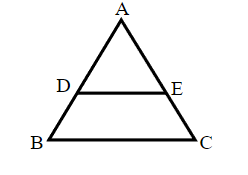
140
120
160
180
Hint: When two triangles are similar, the ratio of their areas is proportional to the square of the ratio of the respective sides. Using this concept, find the area of
Answer:
Given:
Since
So,
⇒ Area of
Hence, the correct answer is 160.
Q3. Suppose
12 cm
18 cm
4 cm
6 cm
Hint: In similar triangles, the ratio of their area is the square of the ratio of corresponding sides. Use this information to solve the question.
Answer:
According to the question,
Given: AC = 9 cm
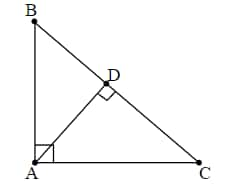
Area of
Area of
⇒
(In similar triangles, the ratio of their area is the square of the ratio of corresponding sides.)
⇒
⇒
⇒
Hence, the correct answer is 18 cm.
Q4. In the given figure, the triangle PQR is right-angled at Q. If PQ = 35 cm and QS = 28 cm and a semicircle passes from the point QRS, then what is the value (in cm) of SR?
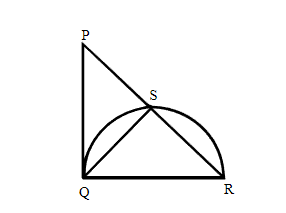
35.33
37.33
41.33
43.33
Hint: The angle made by the circle's diameter is a right angle.
Answer:
Given: Triangle PQR is right-angled at Q. If PQ = 35 cm and QS = 28 cm and a semicircle passes from the point QRS.
We know the angle made by the circle's diameter is a right angle.
So,
⇒
Now applying Pythagoras theorem in
PS =
⇒ PS = 21 cm
Also,
So,
⇒ SR =
⇒ SR =
⇒ SR =
⇒ SR = 37.33 cm
Hence, the correct answer is 37.33.
Q5. In
1 : 1
Hint: First, prove the similarity of triangles and then use the area of similar triangles theorem to solve the rest.
Answer:
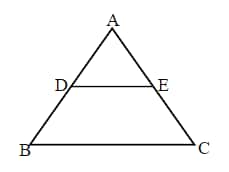
Area(
⇒ Area(
⇒ 2 × Area(
In
⇒
⇒
⇒
⇒
⇒
⇒ AB =
⇒ AD + BD =
⇒ BD =
⇒ AD : BD =
Hence, the correct answer is
Q6. ABC is a triangle in which DE || BC and AD : DB = 5 : 4. Then DE : BC is:
4 : 5
5 : 9
9 : 5
5 : 7
Hint: Use the concept of similar triangles to solve this.
Answer:
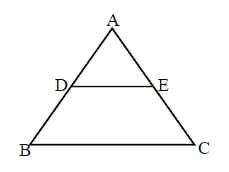
AD : DB = 5 : 4
In
⇒
⇒
⇒
⇒
Hence, the correct answer is 5 : 9.
Q7.
Hint: Use the concept of similar triangles to solve this.
Answer:
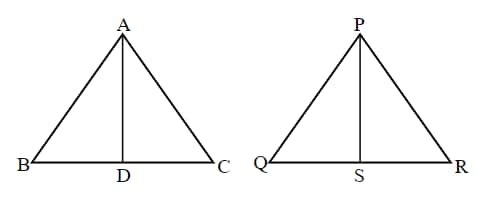
AB : PQ = 2 : 3
As
Hence, the correct answer is
Q8. Triangle ABC and DEF are similar. If AB = 92 cm, BC = 48 cm, AC =120 cm, and the length of the smallest side of triangle DEF is 200 cm, find the longest side of triangle DEF.
400 cm
225 cm
350 cm
500 cm
Hint:
⇒
Answer:
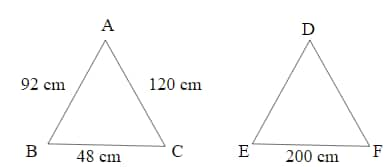
Given
⇒
⇒
⇒
⇒
⇒
So, the longest side of triangle DEF is 500 cm.
Hence, the correct answer is 500 cm.
Q9. If the ratio of corresponding sides of two similar triangles is
Hint: The ratio of areas of similar triangles is equal to the square of the ratio of sides of those similar triangles. Use this to solve the problem.
Answer:
Given, the ratio of sides of similar triangles =
We know the ratio of areas of similar triangles equals the square of the ratio of sides of those similar triangles.
Hence, the correct answer is
Q10. If
12 cm
10 cm
14 cm
8 cm
Hint: As
⇒
Answer:
Given,
As
⇒
⇒
Hence, the correct answer is 12 cm.
Frequently Asked Questions (FAQs)
In similar triangles, the pairs of corresponding sides are in proportion. This relation of corresponding sides can be used to find the length of the missing side of a figure, given a similar figure for which the corresponding measurements are known.
Example: If in two similar triangles ABC and DEF, side AB, BC, AC, DE, and EF are given.
To find the length of side DF, we can use their proportionality.
i.e., AB/DE = BC/DE = AC/DF
There are several criteria for two triangles to be similar. Those are:
Angle-Angle(AA) Similarity Criterion
Side-Angle-Side(SAS) Similarity Criterion
Side-Side-Side(SSS) Similarity Criterion
Properties of similar triangles are:
Corresponding angles of similar triangles are equal.
If ABC ~ XYZ, then ∠A = ∠X, ∠B = ∠Y, and ∠C = ∠Z
Corresponding sides of similar triangles are in proportion.
If ABC ~ XYZ, then AB/XY = BC/YZ = XZ/AC
The ratio of the areas of two similar triangles is equal to the square of the ratio of their corresponding sides.
If ABC ~ DEF, then
The ratio of the perimeters of two similar triangles is equal to the ratio of their corresponding sides.
If ABC ~ DEF, then
In similar triangles, the ratio of the corresponding altitudes, medians, and angle bisectors is equal to the ratio of the corresponding sides.
Similarity is denoted by the symbol “~”.
If figure A is similar to figure B, then we can say that A ~ B.
This symbol means two shapes have same shapes but not necessarily same size.
Angle-Angle-Angle(AAA) Similarity Criterion states that triangles are similar if all three angles of one triangle are equal to all three angles of another triangle.
Suppose there are two triangles ABC and EFG.
Then ABC and EFG are similar triangles if all angles between them are equal.
Let
Then,

